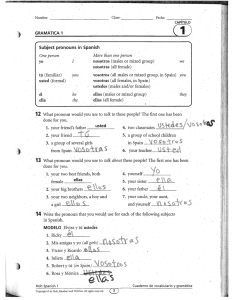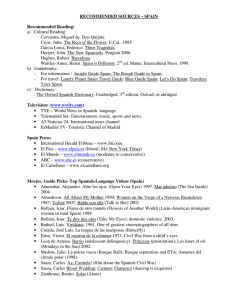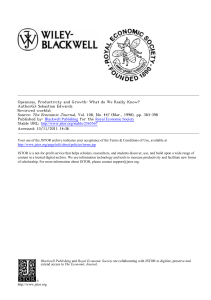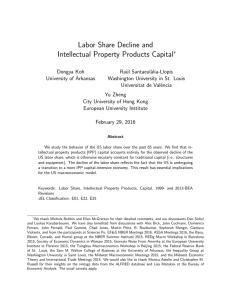Productivity, Taxes, and Hours Worked in Spain
Anuncio
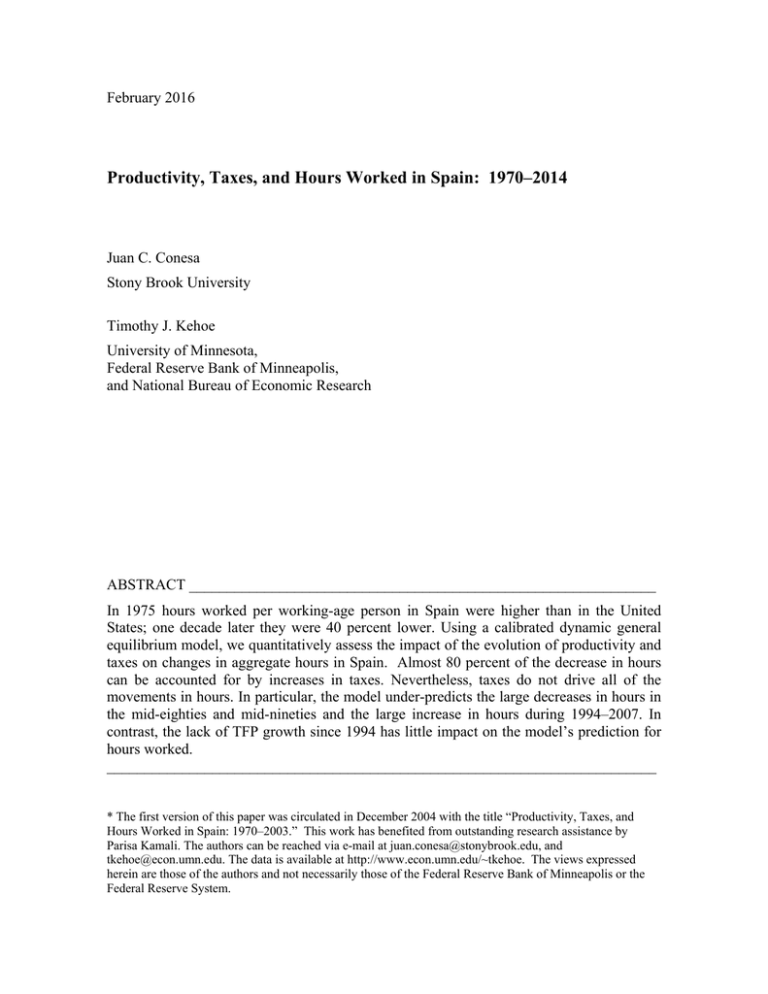
February 2016 Productivity, Taxes, and Hours Worked in Spain: 1970–2014 Juan C. Conesa Stony Brook University Timothy J. Kehoe University of Minnesota, Federal Reserve Bank of Minneapolis, and National Bureau of Economic Research ABSTRACT ______________________________________________________________ In 1975 hours worked per working-age person in Spain were higher than in the United States; one decade later they were 40 percent lower. Using a calibrated dynamic general equilibrium model, we quantitatively assess the impact of the evolution of productivity and taxes on changes in aggregate hours in Spain. Almost 80 percent of the decrease in hours can be accounted for by increases in taxes. Nevertheless, taxes do not drive all of the movements in hours. In particular, the model under-predicts the large decreases in hours in the mid-eighties and mid-nineties and the large increase in hours during 1994–2007. In contrast, the lack of TFP growth since 1994 has little impact on the model’s prediction for hours worked. _________________________________________________________________________ * The first version of this paper was circulated in December 2004 with the title “Productivity, Taxes, and Hours Worked in Spain: 1970–2003.” This work has benefited from outstanding research assistance by Parisa Kamali. The authors can be reached via e-mail at [email protected], and [email protected]. The data is available at http://www.econ.umn.edu/~tkehoe. The views expressed herein are those of the authors and not necessarily those of the Federal Reserve Bank of Minneapolis or the Federal Reserve System. 1. Introduction What has driven output growth and fluctuations in Spain for the last three decades? What is the impact of the evolution of taxes and total factor productivity (TFP) on aggregate hours worked and output? We study these questions through the lens of growth accounting and the neoclassical growth model. Our results show that the evolution of aggregate hours worked in Spain is consistent with the evolution of taxes from a neoclassical growth perspective, while lack of TFP growth has a negligible impact. The methodology used is the one introduced in Kehoe and Prescott (2002), following the steps of a similar methodology proposed in Cole and Ohanian (1999) to the study of the U.S. Great Depression. Conesa, Kehoe, and Ruhl (2007) provide a general exposition of the methodology and explain how to extend it to different model environments. In the first step, we use growth accounting to quantify the contribution of TFP, capital deepening, and aggregate hours worked for the dynamics of output. Next, we construct a standard neoclassical growth model in which a stand-in household chooses hours worked, consumption, and savings in the form of capital holdings, taking as given the deterministic evolution of TFP and tax rates. Such a methodology provides a quantitative tool, at the same time that identifies the relevant margins for potential candidate explanations. Prior to 1975 TFP and output per working age person co-moved in Spain. After 1975, however, this is not the case anymore. The reason is the beginning of a generalized process of decreasing aggregate hours worked. That observation is in sharp contrast with the US experience, where hours worked per adult have been roughly constant. Spain is just an extreme case of “European-like” labor market dynamics. Such differential labor market experiences between US and Europe have been extensively studied in the literature. Most of the literature in this research area has focused on the impact of differences in labor market institutions. Bentolila and Bertola (1990), Blanchard and Jimeno (1995), Blanchard and Summers (1986) or Alesina et al. (2005) among others, focus on the role of institutions and labor market restrictions. Sargent and Ljungqvist (1999, 2002) focus on the interaction between shocks and institutions in a labor 2 search model. Prescott (2002, 2004), however, argues that differential taxation alone might account for the differences in the current level of aggregate hours worked between Europe and the US. Ohanian, Raffo, and Rogerson (2008) provide a comparison across OECD countries. Our analysis shows that the evolution of the taxation of consumption and factor earnings can account for the secular trend decrease in hours worked in Spain. Of course our exercise is silent about the distribution of aggregate hours worked within the working age population. Also, the exercise proposed allows us to identify time periods in which data deviates from theory in a quantitatively important way. We want to identify these episodes, since they suggest avenues for future research. In particular, the comparison between the model outcomes and the data reveals that in periods of large changes in aggregate hours worked, the model systematically under-estimates the magnitude of such changes. This applies to the low levels of hours worked in the mid eighties and the mid nineties, and also applies to the large increase in hours in the 2000-2007 period. This observation is consistent with the findings in Bentolila et al. (2012), that attribute the differential labor market response between Spain and France during the 2008-09 recession to the duality of Spanish labor market institutions. Dalton Business Cycle Accounting 2. The growth accounting exercise The Great Depressions methodology is designed to detect and analyze large deviations from balanced growth behavior. Kehoe and Prescott (2002) use economic theory in the form of the neoclassical growth model to guide their view of economic data. The model features an aggregate production function of the Cobb-Douglas form, Yt At K t L , t (1) where Yt is output, At is total factor productivity (TFP), K t is capital and Lt is labor input. If population grows at a constant rate, N t N 0 t , and TFP grows at a constant rate, At A0 1 t , then the economy has a balanced growth path in which all quantities per working age person grow at the rate 1 except hours worked per working age person, which is constant. 3 Kehoe and Prescott (2002) rewrite the production function (1) as /(1 ) K Yt At1/(1 ) t Nt Yt Lt Nt . (2) They note that, along a balanced growth path, when At grows at a constant rate, the capitaloutput ratio K t / Yt and hours worked per working age person Lt / N t are constant. Figure 1 depicts the decomposition of the growth of output per working age Yt / N t in Spain over the period 1970-2013 into the three factors At1/(1 ) , K t / Yt /(1 ) , and Lt / N t . Notice that Spain has experience large and persistent deviations from a balanced growth path, since the growth in Yt / N t differs from that in At1/(1 ) , and K t / Yt /(1 ) and Lt / N t are not constant. To construct graphs like figure 1, we assemble data on annual GDP and investment from national accounts. Real investment is nominal investment deflated by the GDP deflator. The capital stock is calculated by cumulating investment: K t 1 (1 ) K t I t , (3) where the depreciation rate is calibrated so that the ratio of capital consumption to GDP, K t / Yt matches its average value in the data. We need to choose an initial value for the capital stock in equation (3). A simple way to do this is to choose this value assuming that the growth rate of the capital-output ratio in the initial period is equal to the average for the first decade of data, K1955 / Y1955 1 1963 K t 1 / Yt 1 , K1954 / Y1954 9 t 1955 K t / Yt (4) Notice that, if we have many years of data before the period in which we are interested, the choice of the initial value of capital would make little difference. For the growth accounting reported in figure 1, we have data on investment and GDP starting in 1954. We calibrate 0.0480 . We also use national income accounts to calibrate the capital share . We obtain 0.3709 . See the data appendix for details. Starting in 1975, the Spanish economy diverges sharply from a balanced growth path. Output per working age person Yt / N t grows more slowly than does the productivity factor 4 At1/(1 ) because hours worked per working age person Lt / N t falls sharply, even though there is a sharp increase in the capital output factor K t / Yt /(1 ) . Between 1974 and 1985 hours per working age person fall by about 40 percent. Over the next ten years, hours fluctuate, and in 1995 they begin to rise until they fall again in 2008. 3. The Theoretical Framework We follow Cole and Ohanian (1999) and Kehoe and Prescott (2002) in using a simple general equilibrium growth model to match theory with data and to identify failures of the theory. The model has a stand-in consumer who has utility for consumption and leisure and who makes decisions on labor and leisure and on consumption and investment. There is a one-sector production technology, and the economy is closed to foreign trade. The government transfers tax revenue (in excess of government consumption) to the consumer as a lump sum so as to balance the budget every period. The consumer has perfect foresight over the evolution of all the exogenous variables: population, taxes, government consumption, lump-sum transfers and TFP. The consumer’s maximization problem is max t 1970 t [ log Ct (1 ) log( N t h Lt )] s.t. (1 tc )Ct K t 1 K t (1 t ) wt Lt (1 tk )rt K t Tt . (5) K1970 K1970 Here N t denotes the number of working-age population in the economy and h denotes the yearly disposable time endowment of each individual. The fiscal variables that the household sector takes as given are the taxes on consumption, labor income and net capital income: tc , t , tk , and the transfers Tt . The choice variables are then sequences of aggregate consumption levels Ct , aggregate capital stocks K t , and levels of aggregate hours worked Lt . In each period, the resource constraint is Ct K t 1 (1 ) K t Gt At K t L1t . 5 The government budget constraint is tc Ct t wt Lt tk rt K t Gt Tt . The familiar conditions for cost minimization and zero profits are wt (1 ) At K t Lt rt At K t 1 Lt1 Our benchmark specification implies that all tax proceeds in excess of government consumption are rebated to the consumer in a lump-sum fashion. There are two reasons for doing so. First, because we are measuring marginal tax rates instead of average tax rates, so it is reasonable to lump-sum rebate the difference. Second, because a very large fraction of the government’s budget is used to finance transfers directly. In fact, looking at the composition of government expenditure we find that the sum of pensions, healthcare, unemployment insurance and education in Spain amounts to more than half of the government outlays. In contrast, this specification implies that all of government consumption is a waste, or equivalently it finances some public good that enters utility in a separable fashion. Notice that this specification is not neutral in determining the implication of taxes for hours worked. We will later explore the implications of this specification, assuming instead that all government revenues are rebated to the consumers. Incidentally, we abstract from government debt since the model is Ricardian with respect to the timing of transfers. The existence of government debt would only change the timing of transfers, leaving all other variables unaffected. Of course the model is not fully Ricardian since taxes are distortionary, but that only means that the timing of taxes matters but not the timing of debt/transfer schemes. 4. The Evolution of fiscal variables We obtain estimates of effective marginal tax rates using a methodology similar to that of Mendoza, Razin, and Tesar (1994). Our methodology differs from theirs in two respects: First, we attribute a fraction of household’s nonwage income to labor income to be consistent with our estimate of the capital share . Second, we measure marginal as compared to average tax rates. 6 Estimating effective marginal tax rates requires that we take into account the progressivity of income taxes. Taxation of labor earnings can be decomposed into income taxation and payroll taxes (mainly social security contributions, that are roughly proportional). Provided that the relevant figure in terms of the distortionary implications is the marginal and not the average tax rate, we adjust by 83% (according to the measurement in Calonge and Conesa (2003)) the taxation of households’ income in order to compute effective marginal tax rates. This adjustment is constant over time and only affects the levels of tax rates, not its evolution over time (which is the issue we care about). Our final estimates are reported in Figure 2. Figure 3 reports the evolution of government consumption. 5. Calibration and Numerical Experiment In the experiment we perform, our theoretical economy will determine the equilibrium evolution of the endogenous variables, given the initial capital stock in 1970 as measured in the data. Our theoretical economy will react to the evolution of the exogenous variables, which are the evolution of TFP as measured in the growth decomposition exercise, the evolution of the tax rates as estimated from the data, and the evolution of the working-age population as measured in the data. Then, we will compare the evolution of the main aggregate variables implied by the model with those observed in the data. In order to determine the value of the disposable time endowment of individuals, h , we assume that each adult has a time endowment of 100 hours a week. Next, we need to assign values to all the parameters in the model. The depreciation rate is chosen so that the ratio of depreciation to GDP coincides with that observed in the data on average between 1970 and 2014. Therefore, we choose 0.0480 so that we obtain t 1970 2014 Kt / 45 0.1385 . Yt Our estimate of the capital share in Spain is 0.3709. This estimate is obtained by using the same national accounting data as the one used for the TFP accounting exercise and for the estimation of the marginal tax rates. 7 In order to calibrate the preference parameters we use the first order conditions from the household problem and the data observations for the period 1970-2014. Deriving the two first order conditions and rearranging we can write the value of the preference parameters as a function of data observations: (1 tc1 )Ct 1 1 c (1 t )Ct 1 (1 tk )( rt ) (1 tc )Ct (1 tc )Ct (1 t ) wt ( N t h Lt ) Using these two conditions and actual data we can compute annual observations for the parameters and . The parameters we assign to our economy are the average over the period 1970-2014. As such, we are forcing our model to be consistent with the average consumption growth observed in the data and with the average hours worked observed in the data. In contrast, our calibration strategy does not impose any properties on the time series of the model economy, which is the object we want to compare to the data. We will later explore the sensitivity of our analysis to the choice of the time period used for calibration. Given that our goal is to quantify the implications of the evolution of taxes our main exercise is to compare our benchmark model results with a counterfactual where taxes and government consumption are held constant at their initial levels. 6. The results for the benchmark economy Figure 4 shows the evolution of the benchmark economy relative to the data. Notice that the model does reasonably well until the mid-nineties, but it fails to predict the output boom of the period 1994-2008. However, the data shows a significantly larger movement in hours relative to the model predictions, both when hours reach their minimum points (in 1984 and 1994) and when they reach their maximum (in 2007). In order to understand the role of changes in taxes and government consumption we compare the benchmark economy to a counterfactual leaving taxes and government 8 consumption constant at their initial levels. Figure 5 reports the simulated economy under a constant tax and public expenditure scenario. Our exercise shows that the key component driving output is the evolution of hours worked, and that the distortions introduced by fiscal policy in the labor market have had a non-negligible impact. We do not want to claim, however, that other frictions or institutional features in the labor market have no role in explaining the evolution of hours worked. Indeed, tax revenues have been used to some extent to finance certain institutional programs such as unemployment insurance or publicly provided retirement pensions. To the extent that the increase in taxes has been contemporaneous to the development of these programs, alternative explanations are clearly correlated with the evolution of taxes. 7. Sensitivity to the calibration period We compare our results to a model economy where we calibrate the preference parameters ( , ) using data for the initial periods of our economy 1970-74, right before the beginning of the large fall in hours worked. When we recalibrate to the initial period we find a lower value of (0.94 as compared to 0.97 in the benchmark economy), and a higher value of (0.28 compared to 0.27). These values reflect the fact that capital accumulation was slower in the early seventies and hours worked larger than their equivalent for the overall sample period. Figure 6 plots the results. The choice of the calibration period matters a lot for the capital accumulation factor, which would be severely underestimated with a smaller value of the discount factor. However, hours worked are virtually unchanged with the alternative calibration strategy. 8. The role of the lack of technological growth In order to understand the role of lack of productivity growth we perform the following counterfactual experiment. We ask the model what would have happened if productivity growth after 1993 would have proceeded at the average rhythm observed in the preceding period 1970-1993 (we measure a 1.5% growth rate of total factor productivity). 9 Figure 7 suggests that the lack of productivity growth is very important for understanding the evolution of GDP per working age person, but that its impact on hours worked is negligible. 9. Summary and conclusions In this paper we have argued that introducing exogenously the evolution of tax rates in a suitably parameterized neoclassical growth model can be used as an important tool for understanding the labor market experience in Spain. Our quantitative results suggest that the trend of aggregate hours worked in Spain is roughly consistent with neoclassical growth theory given the observed trend of taxes and the size of the government. Nevertheless, in times where there are large movements in hours worked, the model systematically under-predicts the magnitude of these changes. Recent research suggest that the institutional arrangements of the Spanish labor market imply a larger reaction of hours worked or employment to shocks. See Bentolila et al (2012) for an analysis of the differential response of France and Spain to the recent recession. Our results are perfectly compatible with this analysis. Perhaps surprisingly, the lack of TFP growth in Spain since 1994 does not generate a substantial impact on the evolution of hours worked in our model economy. Our conclusion is that the general trend of falling hours worked can be understood as a reasonable implication of the development of the welfare state in European economies, with increasing taxes and government consumption. Nevertheless, when looking at the specific movements from one period to the next, the evolution of hours is not necessarily aligned with the observed timing of tax changes. References Bentolila, S., P. Cahuc, J. Dolado and T. Le Barbanchon (2012), “Two-tier labor markets in the Great Recession: France vs Spain,” The Economic Journal. Cole, H. L. and L. E. Ohanian (1999), “The Great Depression in the United States from a Neo-classical Perspective.” Federal Reserve Bank of Minneapolis Quarterly Review, Winter 1999, 23(1), pp. 2-24. 10 Conesa, J.C., T.J. Kehoe and K. Ruhl (2007), “Modelling great depressions: The depression in Finland in the 1990’s”, Federal Reserve Bank of Minneapolis Quarterly Review 31, 1644. Gouveia, M. and R.P.Strauss (1994):“Effective federal individual income tax functions:An exploratory empirical analysis ”,National Tax Journal 47, pp.317-39. Kehoe, T. and E. C. Prescott (eds., 2002), “Great Depressions of the 20th Century,” Review of Economic Dynamics. Mendoza, E., L. Tesar, and A. Razin (1994), “Effective Tax Rates in Macroeconomics. Cross-country Estimates of Tax Rates on Factor Incomes and Consumption,” Journal of Monetary Economics, 34. Ohanian, L., A. Raffo, and R. Rogerson (2008), “Long-term changes in labor supply and taxes: Evidence from OECD countries, 1956-2004,” Journal of Monetary Economics 55, 1353-1362. Prescott, E. C. (2004), “Why Do Americans Work So Much More Than Europeans?,”.Quarterly Review of the Federal Reserve Bank of Minneapolis 28, 1, 2-13. 11 Figure 1: Growth accounting for Spain 230 Yt / N t 210 Index 1970 = 100 190 At1/(1 ) 170 150 130 K t / Yt 110 /(1 ) 90 70 50 1970 1980 1990 12 2000 2010 Figure 2: Evolution of effective marginal tax rates 0.6 0.5 Taxes on labor 0.4 0.3 Taxes on capital 0.2 0.1 0 1970 1980 1990 13 2000 2010 Figure 3: Evolution of government consumption 25.00 percent GDP 20.00 15.00 10.00 5.00 0.00 1970 1975 1980 1985 1990 14 1995 2000 2005 2010 Figure 4: The Benchmark model and the data GDP per working age person 40000 Data 35000 30000 Euros 2010 Model 25000 20000 15000 10000 5000 0 1970 1980 1990 2000 2010 Capital-output ratio 4.5 4 Data 3.5 3 Ratio Model 2.5 2 1.5 1 0.5 0 1970 1980 1990 2000 2010 Hours worked per working-age person (per week) 28 26 24 Data Hours per week 22 20 18 Model 16 14 12 10 1970 1980 1990 15 2000 2010 Figure 5: The Benchmark model, the model with constant taxes and the data GDP per working age person 40000 35000 Model Constant Taxes Data Euros 2010 30000 Model with taxes 25000 20000 15000 10000 5000 0 1970 1980 1990 2000 2010 Capital-output ratio 4.5 4 Model Constant Taxes 3.5 Ratio 3 Model with taxes Data 2.5 2 1.5 1 0.5 0 1970 1980 1990 2000 2010 Hours worked per working-age person (per week) 28 26 Model Constant Taxes 24 Hours per week 22 20 18 Model with taxes 16 Data 14 12 10 1970 1980 1990 16 2000 2010 Figure 6: The benchmark model, the recalibrated model and the data GDP per working age person 40000 Data 35000 30000 Benchmark model Euros 2010 25000 Recalibrated model 20000 15000 10000 5000 0 1970 1980 1990 2000 2010 Capital-output ratio 4.5 4 Data 3.5 Benchmark model Ratio 3 2.5 2 Recalibrated model 1.5 1 0.5 0 1970 1980 1990 2000 2010 Hours worked per working-age person (per week) 28 26 24 Benchmark model Data Hours per week 22 20 18 Recalibrated model 16 14 12 10 1970 1980 1990 17 2000 2010 Figure 7: The benchmark model, the TFP growth model and the data GDP per working age person 40000 Data 35000 30000 Benchmark model Euros 2010 25000 Model constant productivity growth 20000 15000 10000 5000 0 1970 1980 1990 2000 2010 Capital-output ratio 4.5 4 Data 3.5 Benchmark model Ratio 3 2.5 Model constant productivity growth 2 1.5 1 0.5 0 1970 1980 1990 2000 2010 Hours worked per working-age person (per week) 28 26 Benchmark model 24 Data Hours per week 22 20 18 16 Model constant 14 12 10 1970 1980 1990 18 2000 2010 19
